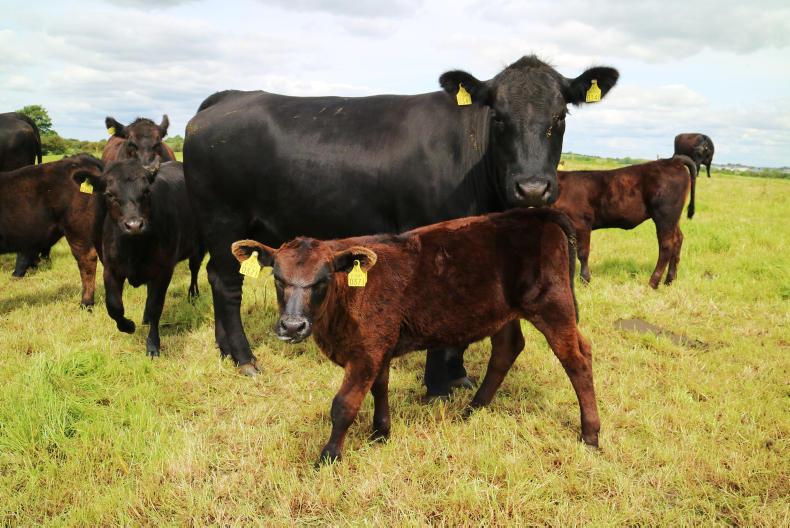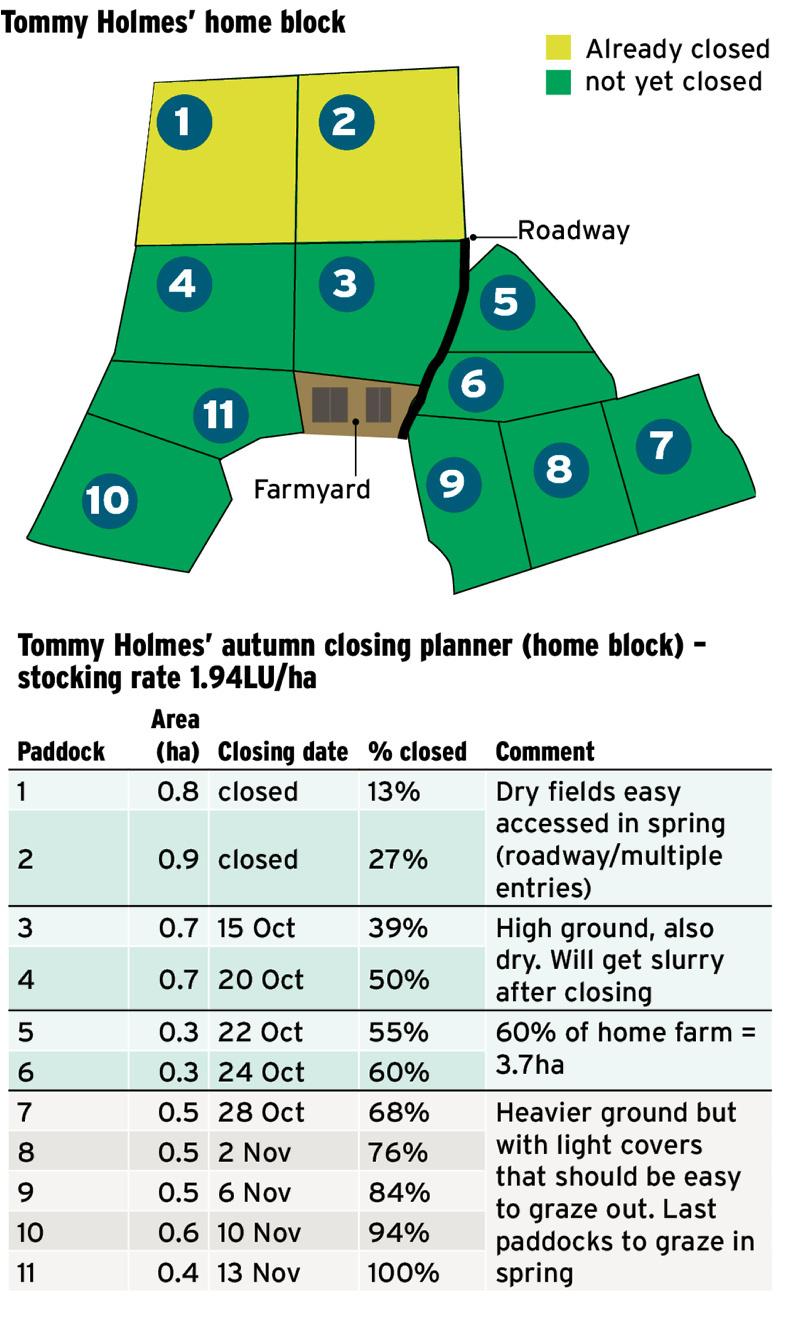Mayo BETTER beef representative Tommy Holmes was already well versed in grassland management beginning the programme. He had invested in fencing, strategically placed drinkers and small distances of roadways in the years prior to BETTER farm. Tommy was also measuring grass weekly and using the Pasturebase system to aid him in his grassland management decisions.

Tommy farms on 18 fragmented hectares on the outskirts of Ballina, keeping 20 suckler cows. A stock bull problem some years back threw his calving spread out of kilter – there were eight months with a calving event in the year to June 2017.
At present, Tommy is actively culling and sourcing new females and the plan is to calve 25 sucklers in eight weeks from the beginning of August. Traditionally an Angus-man, Tommy will move towards a more continental cow base as he looks to drive up carcase weights. However, a focus on important maternal traits such as milk and fertility will remain when selecting bulls – Tommy breeds most of his cows to AI. Going forward, the plan is to complement his own sucklers with bought-in finishing stock, using sheds otherwise empty during the main grass season and boosting farm output.
Grass 10
Last week, Tommy opened his gates for the latest in a series of beef Grass 10 walks. The aim of the Grass 10 programme is to increase the amount of grass grown and utilised on Irish livestock farms and thus improve profit margins. Every extra tonne of grass dry matter utilised is worth an additional €105 net profit to a beef farmer. At present, the average farm is utilising somewhere between 5t and 7t of grass per hectare – the aim of Grass 10 is to target 10t utilised per hectare annually, achieving 10 grazings per paddock while doing so.

Grazing in the year’s shoulders is something we are weak at as a sector. Many are hesitant to go to grass early in the year, particularly those farming prevailing heavy soils. However, with the right strategies and infrastructure in place, early and late grazing can and is being achieved on heavy farms, like Tommy’s. Every extra day at grass is worth €1.80 per head to a farmer in the autumn and €2.70 in the spring. Often, when the opportunity presents itself to turn out light stock early in the year or to go out on dry parts of the farm, there is no grass present.
This is where an autumn rotation planner comes in. Two-thirds of the grass on a farm in the spring will have been produced the previous October. To ensure we have material to graze in the spring, we begin closing up farms in the first weeks of October – towards the beginning/late September for wet farms and the middle of the month on drier ground.
The important target around autumn closing is the “60% closed” figure – the area encompassed in this is where your grass will be in the spring. We should be hitting this 60% target no later than five weeks after closing begins.
The table and map below outline Tommy’s plan for closing up his paddocks this autumn. Note how he has first closed up the paddocks (1 & 2) he can get to early in the spring – dry ground with multiple gaps and access via roadways. Here cattle could potentially be stood off in periods of heavy rain or easily run back into a nearby shed if the weather turned sour. He will look to turn out light stock such as bull weanlings here in early March, having spread urea in late-January/early-February.

Draw up a plan like Tommy’s for your home farm. If you are not on track to hit your 60% in time, start moving into lighter covers that your animals will graze out quicker. It’s important to graze out paddocks as best we can during closing, to ensure maximum leaf in the sward next spring.
Adviser comment
John Greaney
Tommy is probably ahead of the other farmers in the programme when it comes to grass. He measures every week and his grassland management is exceptional. It’ll be the cornerstone for driving output on the farm as he plans on going to over 3LU/ha, a figure which would scare most farmers in the northwest. The quality of stock on the farm needs to be improved and he has started to clear out some of the older cows.
Mayo BETTER beef representative Tommy Holmes was already well versed in grassland management beginning the programme. He had invested in fencing, strategically placed drinkers and small distances of roadways in the years prior to BETTER farm. Tommy was also measuring grass weekly and using the Pasturebase system to aid him in his grassland management decisions.

Tommy farms on 18 fragmented hectares on the outskirts of Ballina, keeping 20 suckler cows. A stock bull problem some years back threw his calving spread out of kilter – there were eight months with a calving event in the year to June 2017.
At present, Tommy is actively culling and sourcing new females and the plan is to calve 25 sucklers in eight weeks from the beginning of August. Traditionally an Angus-man, Tommy will move towards a more continental cow base as he looks to drive up carcase weights. However, a focus on important maternal traits such as milk and fertility will remain when selecting bulls – Tommy breeds most of his cows to AI. Going forward, the plan is to complement his own sucklers with bought-in finishing stock, using sheds otherwise empty during the main grass season and boosting farm output.
Grass 10
Last week, Tommy opened his gates for the latest in a series of beef Grass 10 walks. The aim of the Grass 10 programme is to increase the amount of grass grown and utilised on Irish livestock farms and thus improve profit margins. Every extra tonne of grass dry matter utilised is worth an additional €105 net profit to a beef farmer. At present, the average farm is utilising somewhere between 5t and 7t of grass per hectare – the aim of Grass 10 is to target 10t utilised per hectare annually, achieving 10 grazings per paddock while doing so.

Grazing in the year’s shoulders is something we are weak at as a sector. Many are hesitant to go to grass early in the year, particularly those farming prevailing heavy soils. However, with the right strategies and infrastructure in place, early and late grazing can and is being achieved on heavy farms, like Tommy’s. Every extra day at grass is worth €1.80 per head to a farmer in the autumn and €2.70 in the spring. Often, when the opportunity presents itself to turn out light stock early in the year or to go out on dry parts of the farm, there is no grass present.
This is where an autumn rotation planner comes in. Two-thirds of the grass on a farm in the spring will have been produced the previous October. To ensure we have material to graze in the spring, we begin closing up farms in the first weeks of October – towards the beginning/late September for wet farms and the middle of the month on drier ground.
The important target around autumn closing is the “60% closed” figure – the area encompassed in this is where your grass will be in the spring. We should be hitting this 60% target no later than five weeks after closing begins.
The table and map below outline Tommy’s plan for closing up his paddocks this autumn. Note how he has first closed up the paddocks (1 & 2) he can get to early in the spring – dry ground with multiple gaps and access via roadways. Here cattle could potentially be stood off in periods of heavy rain or easily run back into a nearby shed if the weather turned sour. He will look to turn out light stock such as bull weanlings here in early March, having spread urea in late-January/early-February.

Draw up a plan like Tommy’s for your home farm. If you are not on track to hit your 60% in time, start moving into lighter covers that your animals will graze out quicker. It’s important to graze out paddocks as best we can during closing, to ensure maximum leaf in the sward next spring.
Adviser comment
John Greaney
Tommy is probably ahead of the other farmers in the programme when it comes to grass. He measures every week and his grassland management is exceptional. It’ll be the cornerstone for driving output on the farm as he plans on going to over 3LU/ha, a figure which would scare most farmers in the northwest. The quality of stock on the farm needs to be improved and he has started to clear out some of the older cows.









 This is a subscriber-only article
This is a subscriber-only article





SHARING OPTIONS: